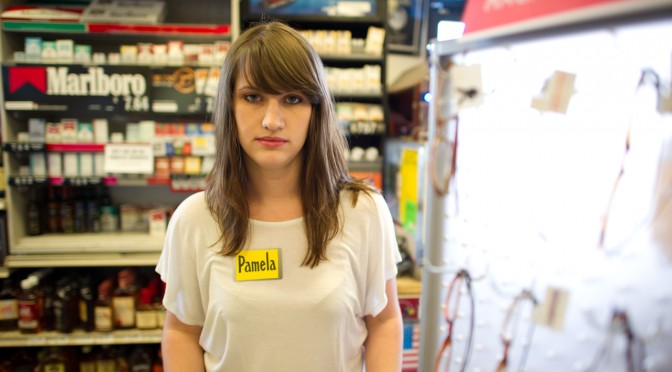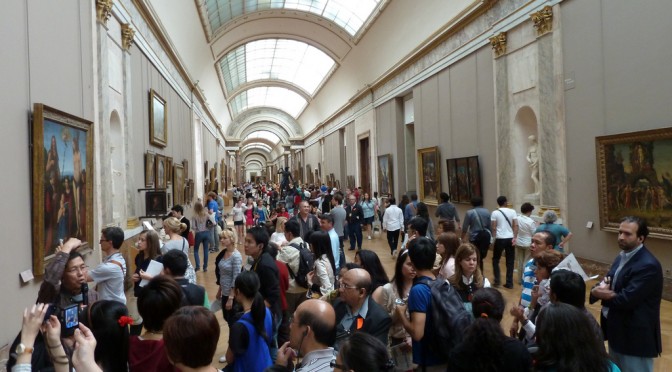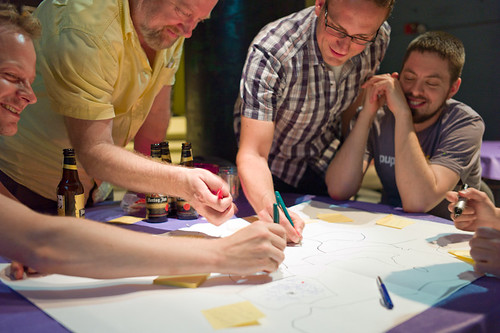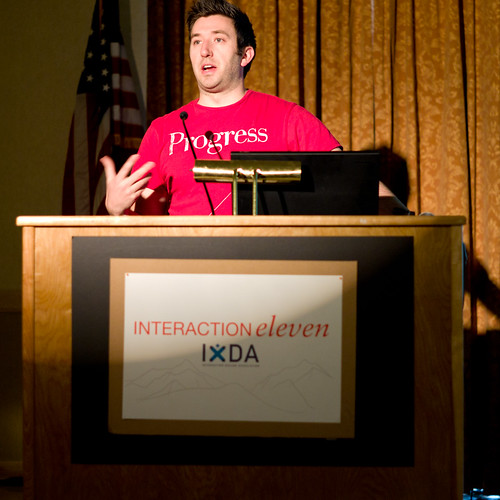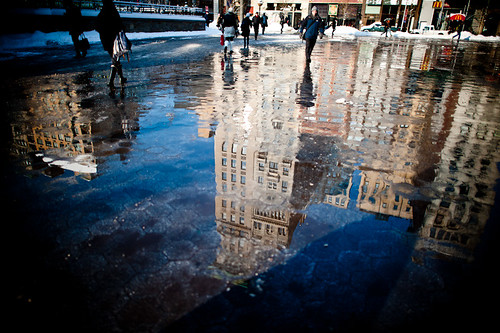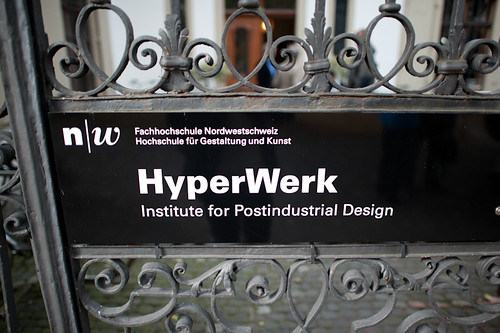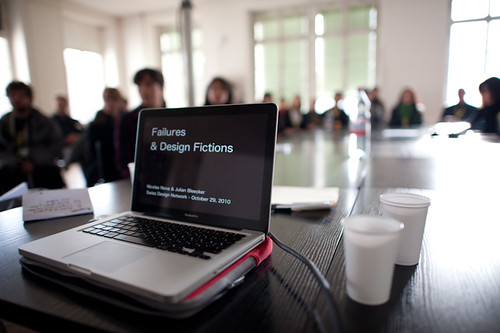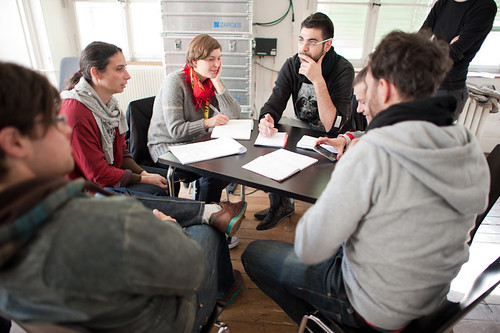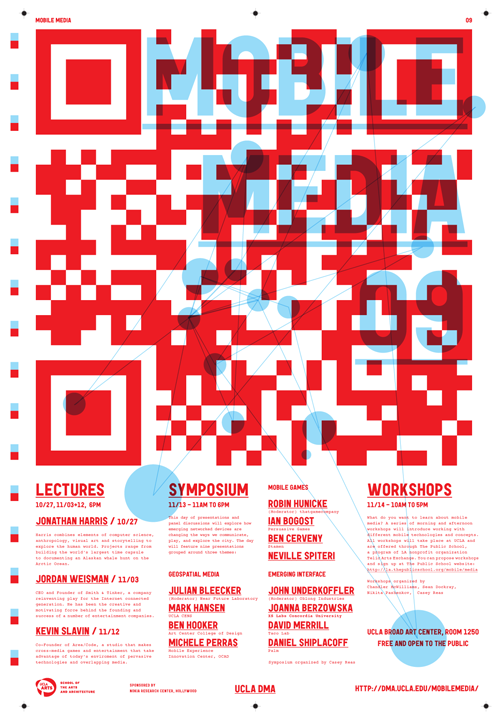Here in Barcelona, we continue fine tuning Quadrigram, with now a meticulous work on the coherence of pre-programmed modules the tool will provide to access, manipulate and visualize data flows. It also means some backstage cleaning and improvements of the engine that supports the visual programming language.
We have also been busy joining forces with our new friends at the user experience & data visualization studio Interactive Things. They have been mandated to produce visualization mobile phone network traffic and we do our best to provide the cleanest and more meaningful pieces of data. Their magic will be presented at Lift 12.
In the meantime, Yuji Yoshimura traveled to Helsingborg, Sweden to present at ENTER2012 a study of the visiting experiences at the Louvre Museum. His paper New tools for studying visitor behaviors in museums: a case study at the Louvre is the result of a collaboration between Universitat Pompeu Fabra, MIT SENSEable City Lab and us. It builds on the data we collected in 2010 to measure hyper-congestion phenomena in the busiest areas of the Louvre.
In Geneva, the week was focused on various projects. It was the last week of teaching at HEAD-Geneva this semester. Last Monday, I gave a course about innovation and usages and another one about design ethnography (which was actually made of students presentation). Tuesday was devoted to meetings in Saint Etienne (France) at Cité du Design, a quite big Design Center located in an old and beautiful manufacture. Then I (Nicolas) gave a presentation there about human-robots interaction (slides are on Slideshare). The rest of the week was spent in meetings with Lift speakers, students (time to discuss their masters thesis!) and watching video material for the current field study about head-mounted displays. The end of this project is pretty soon and we are currently working on the final presentation for the client.
In Los Angeles, Julian was a busy-bee trying to get PCB’s fabricated for the Ear Freshener’s
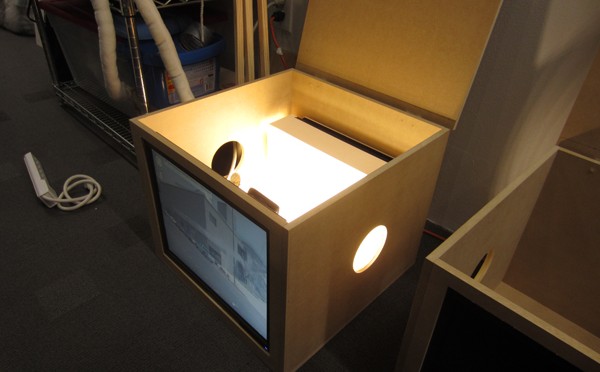
Fabien and Nicolas went to Madrid for a workshop at BBVA innovation about Smart Cities. Organized by Urbanscale (and more specifically by Jeff Kirsh, Adam Greenfield and Leah Meisterlin), it focused on opportunities to use networked data for the client. It basically followed up on the previous work we have done with this bank last year.
The workshop went well, with a combination of short talks, field observations (qualitative and quantitative) and discussions. This workshop was followed by an open session entitled “Beyond Smart Cities” at BBVA’s Innovation Center, with Adam Greenfield, myself (Nicolas) and Kevin Slavin. My slides are on Slideshare. There’s a write-up of the event at the following URL. As described by Kevin on his tumblog, “As surely as it feels like a movement has a name (“Smart Cities”) it also feels like the critique of said movement is collectively more articulate and persuasive. Now the key is to find language to describe what it should be, to go beyond popping the balloon and figuring out what the party really needs.“.
Here in Los Angeles Julian has been hard at work puzzling over an incredibly simple problem of making a little audio device called an Ear Freshener avoid having a power switch and a volume knob. He thinks the solution was intimated by a generous comment poster who told him to slap a couple of transistors in strategic locations in the circuit. So he tried that. It seems to make sense. Hopefully it won’t destroy everything.
Related to this were discussions about the principles behind/between things that make sound — such as sound should just come out of them, rather than be all fussy with settings, configurations and network connections. And that tied into an ongoing thinking thing about latter day considerations about “simplicity”, “one thing done well” and skinny Williamsburg/Brick Lane 23 year olds with full beards who’ve done nothing to deserve a full beard but rock Holgas and fetishize film/vinyl/casette tapes fixed-gear bikes and the like. Thus, we’ve been working on a short essay on the topic of the Cult of the Analog Cult. Or something like that.
Meanwhile, on the East side of L.A. Jayne (with Kickstarter funding in hand) has been getting back to making new Portals. They’re still in the physical draft/sketch phase of things but making the upgrade from end-table-foam-core to mdf feels quite satisfying. The insides are still very rough and she’s still getting started with hooking up the magic/technology bits, but at least now a pair of Portal boxes exist in the world, ready to be filled with interactive goodies.
Continue reading Weekending 21012012
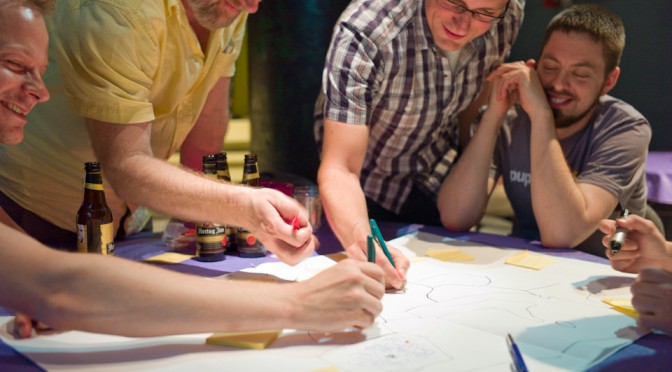
Last week I was at V2_ in Rotterdam to participate in the event “Blowup: The Era of Objects”. It was a brief visit — too brief, of course — but well worth the time to help facilitate this workshop along with Alexandra Deschamps-Sonsino, Anab Jain and curated by Michelle Kasprzak.
There was an EPUB produced for the event containing short essays by Bruce Sterling, Ilona Gaynor, Anab, Alex, myself and others in this: The Era of Objects
The event started with Alex, Anab and myself giving a rapid-fire presentation to lay out some of our own perspectives and work on the theme of “speculative design” — which is an area of design akin to design fiction.
Parenthetically I think it would be worth spending a little bit of time excavating some of the distinctions and contrasts between these various ways of doing design — speculative design, design fiction, critical design — if only to be more specific and open a dialogue about the utility and techniques of these ways of seeing the world a bit differently in order to create new perspectives, principles, points-of-view and the resultant outcomes.
The presentations were short — 20 slides I think was the requirement, done almost pecha kucha style with automatic slide changing after about 30 seconds a slide, so I think we violated pecha kucha trademark rules.
In any case, I cobbled together a perspective on speculative design/design fiction that blurred the boundaries between the two, but also got me started thinking about how the two are distinct.
To start, I outlined three perspectives on what the future is and how it is useful as a way of thinking about what come to be. This is crucial insofar as it’s super important to think from a slightly different angle on what could come to pass. The future isn’t always bigger, brighter, better, better battery life or taller, &c.
To reinforce this I shared several of my “graphs of the future” — some crude hand drawings I made that show various ways in which the future is depicted — linear, logarithmic, a three-dimensional “spread”, a bumpy road of hype curves, &c. This helps reinforce this idea that the future is a point-of-view, which is crafted and created by humans based on a set of ideologies — not in a mean, evil way, but just plainly for the sake of framing what is understood as possible or desirable. Oftentimes though these sorts of points-of-view embedded in graphs are ideological in the sense that they are taken as “law” handed down from somewhere. They’re just points-of-view, like politics and therefore entirely flexible and free to be altered, subverted, re-interpreted and re-graphed.
I then presented what I consider three principles for speculating while designing with fiction:
1) It’s okay to let the imagination wonder — science, technology, design, fact and fiction are all knotted up anyway. By this I mean that once you are working in the broad territory of design, one should not be concerned about steering away from the austere pragmatics of “reality” — one should vector to-and-fro into weird, unexpected territory and flex the realm of what is considered possible. At the same time, be prepared to find that small components of the larger design problem are what one is really after — not so much space-age, fantastical luggage for the future but, in fact — just adding wheels to luggage may be the most significant outcome of getting a “future of luggage” design brief.
2) Realize that stories (and storytelling) are more significant than specifications, feature sets and engineering. As an engineer, this is hard to say, but I believe it more and more every time I’m forced to communicate. The list of sucks. The story, where you can take someone along a path and communicate to them in a way that is engaging and compelling — even if ultimately the base-level of what you are saying is a set of features and the engineering involved — is *much better than just saying what the features are. Show the experience of the design concept in a small story/film/animation/comic book. The hard thing is that telling good stories if really, really difficult. It requires practice and failure and refinement and iteration. I mean — there really aren’t that many good story tellers in the world, but it’s worth aspiring to be at least a satisfactory design storyteller. (Also, parenthetically — I’ve grown weary of the mantra that designers are storytellers. Not because I don’t believe it but because I’d rather see evidence of it, even to the point of workshops and curricula and all that. Maybe I’m overlooking something..a few are; most of course make fast-looking tooth brushes and over plastic-y bits and bobs of landfill.)
3) Science fiction/speculation can do things that science fact/pragmatic reality cannot. It’s more robust to speculate than to cordon off.
Then for the remaining few slides I gave some examples of HOW to speculate with design. These are three approaches/techniques/creative idioms..pastiche, re-enactment/re-imagining, making little films.
1) Pastiche is something I’m quite curious about — a way of moving in and out of reality and fiction, such as turning the reality of the Apollo 11 lunar lander into the cornerstone of an imaginary “owner’s manual” — as if normal humans might own Apollo 11 lunar landers and need to service them in their driveways like normal vehicles rather than highly specialized, hand-built space vessels.
2) Re-enactment/re-imagining, in the particular example I offer of the Tom Sachs project/art-piece “Space Program” is a form of pastiche — replaying an event but altering it subtly to explore alternative futures/pasts.
3) Making little films. I find it extremely useful to make small visual stories that capture the essential characteristics of a design idea. Done quickly without too much preciousness is a great way to iterate on a concept. It forces one to work through many of the aspects of a design fiction/speculation that are very easy to overlook in a static sketch or even a discussion. You have to figure out a number of the important albeit subtle aspects of the design problem. It’s a form of design work, definitely — the film is not just the final communication of an idea; it is design work itself..at least it should be.

Finally, I concluded with two WHY statements..Why speculate with design? Why do design fiction? First, to imagine and see the world from a different perspective. And then of course — speculating and fictionalizing things allows one to imagine and see the world from a non-dominant point-of-view..run against the grain..do the unexpected to nudge things into the realm of new possibilities. Like Dick Fosbury or the guy who decided to bolt some wheels onto the bottom of his barely luggable luggage and thereby roll free around the world.
*shrug.
Following our presentations we entered into a bit of a talk-show style discussion and thence onto the workshop itself. We had three “briefs” for a rapid-iteration design session that was only meant to last about 40 minutes total. Very quick, but these are where interesting things happen. Here were the briefs:
1) The Netherlands. Everyone knows the dikes are going to break and the North Sea is going to begin to cover Holland’s land mass. Despite the best efforts of Dutch engineering prowess, there are “preppers” who want to be sure to be prepared. One is Ries Von Doren — a rich guy who has the resources to do what he wants. In this case, he consults with a design agency to create a disaster communications device because he knows the existing infrastructure (cell phones, emergency networks, etc.) are going to fail. How will he and his family stay in touch?
2) China. Aging population. Robots. How will the robots support the needs of the aged when the numbers reach into the many hundreds of millions?
3) The EU. Things really fall apart in a few months. Deutche Bank takes ownership of Greece. Tensions rise. Travel becomes highly restricted so that engineers from one country cannot get into other countries and so conversations and meetings related to setting and evolving technical standards and interoperability are not able to happen. Soon, systems that connect one country to the other fail to work properly — some countries evolve their internets, others are not able to and very quickly the internet fails to cross borders. The network becomes heavily balkanized. What arises out of this sequence of events? How do people communicate across geographical borders?
I made up the Balkanized Internet one so I listened in on that group. It was good fun. The outcomes were varied but I particularly latched onto this idea that existing infrastructures and systems might be used to facilitate communication — and it may in fact not be the visual internet as we are presently used to. For example, the quaint old RF radio would come back into use, with people using voice and perhaps rudimentary modulation to communicate data/text. DIY low-earth orbit satellite, even buoyed by helium/lighter-than-air systems to set up comms networks. Tapping on rail lines to send low-bandwidth morse-code signals across borders. Slow communication over long-wave. Things like this were all very interesting to imagine.
Why do I blog this? Merely to capture a few points on the week I spent mostly traveling with a few hours doing a workshop. Well worth it, though. I also want to think about a schema of these design approaches — speculative, fiction, critical — to help formalize the distinctions in a useful way.
Just a quick note to say — I’ll be at this event at V2__ in Rotterdam (V2_, Eendrachtsstraat 10, Rotterdam) Thursday September 29..so if you’re around, you should come. If you’re not — you should dial-in: ((This event will be streamed live at http://live.v2.nl))
Beyond the flying car: join top designers Julian Bleecker (Nokia, Near Future Laboratory),
Alexandra Deschamps-Sonsino (Really Interesting Group), and
Anab Jain (Superflux) in an exploration of speculative design.
We are rapidly entering (and perhaps even have already entered) an era where we are able to print 3D objects at our desks, make and share laser-cut gifts for friends, and use off-the-shelf tools to plug these creations into the web and have them send status updates on our behalf. We have some commonly-held visions of the future, but what could our very wildest dreams (and nightmares) look like, beyond the cliché of the flying car? What answers can we find in speculative design? Our expert guests will explore these questions in collaboration with the audience in a hands-on, “open think-tank” format.
Addressing this contemporary issue will be Julian Bleecker: designer, researcher at the Design Strategic Projects studio at Nokia Design and co-founder of Near Future Laboratory; Alexandra Deschamps-Sonsino: product designer, entrepreneur, and partner at Really Interesting Group (London); and Anab Jain: interaction designer, founder of Superflux, and recent TED Fellow.
Following a brief talk show with Julian, Alexandra, and Anab, the audience will have the unique opportunity to collaborate with our invited experts in an “open think-tank”: a guided speculative design session wherein we’ll address the product design challenges of the near and not-so-near future.
Continue reading Speculative Design: Blowup – The Era of Objects
So — enough yammering. Time for some hammering. It’ll be workshops from here to fore. Getting to work. Shirtsleeves. Lab coats. Smocks. Aprons. Hammers.
I’ll be doing a workshop later this summer — August 24 from 2-5:30, to be precise — at the UX Week week-ish long conference in San Francisco brought to you by the fine folks at Adaptive Path. It’s got the didactic title: How the Practice of Design Can Use Fiction to Create New Things. We’re done with fancy, clever, snarky titles for workshops.
It looks like a swell line-up. Old friends. New ones. Fun sounding workshops and methoducation sessions.
Sign up. It’ll be fun.
====
From Dick Fosbury to the guy who put wheels on luggage, creating disruptions to convention in positive ways has often meant looking at the world differently. Fiction, especially science fiction, is a way of telling a story about and then forcing one to think about the world by looking at it with a different lens.
Design can approach its creative and conceptual challenges to make things better, or to think differently or to disrupt convention by combining its practice with that of fiction.
In this workshop we will look at the practical ways of employing the rhetorical, creative and cinematic aspects of fiction to help think, act upon, design and create new things.
The principle is simple. If cinematic and literary fiction is able to help imagine and communicate things that may not be possible, how can these same forms of story telling help design practices create disruptive visions of the near future?
In the workshop will share a number of relevant case studies where design and fiction were brought together. The process and outcomes of these case studies will be discussed. Through these case studies we’ll discover approaches, techniques and principles for a pragmatic designing-with-fiction process.
Prerequisites:
An open mind, notebook, pen. Familiarity with science-fiction film, optional.
Outcomes:
A set of tools, approaches and processes for initiating practical design fiction in the studio.
Continue reading Design Fiction Workshop at UX Week 2011
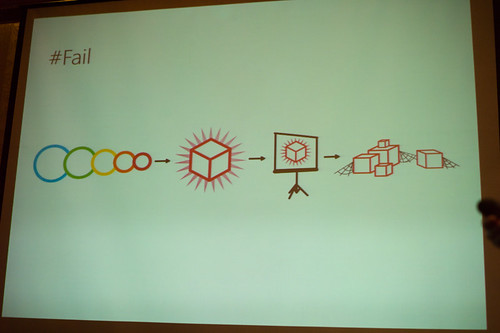
The problem that occurs when a clever, *advanced idea is inserted into a machine that is already optimized for itself — for efficiency. Just because it’s bright and clever and has colors doesn’t mean that it can find a place to fit in a process that is either (a) already humming along or, (b) unwilling or unable to change and adapt its workflow to allow something to drop into place. From my perspective, this means that it requires either a crisis which *forces the machine to stop and change itself — which is painful — or the machine needs to be changed from the outset to accommodate advanced design that does not come from left field but is accepted as something that is routine and part of the machine itself.
Some notes from Mike Kruzeniski‘s workshop at IxD11 on the topic of Designing Advanced Design. This is a fascinating topic to The Laboratory and equally fascinating to hear it from and participate with Mike, who is a good friend and former colleague at Nokia, of all things. Mike’s now at Microsoft so, like..now it might be like we’re colleagues again! At least partners in doing fascinating and unexpected things in the realm of design and technology.
Anyway. There were a number of highlights that I think are relevant. I’ll start with the general structure of the workshop, which was a workshop. ((Parenthetically, I’m a bit confused by workshops that are more someone presenting than people getting their hands a bit dirty, or going out in the world, or ignoring their iPad/iPhone update status checkers. I would even say that I don’t get the real-time twammering in a workshop. Either be there, or don’t be there. Bring a notebook. Sharpen your pen. Listen, do, speak. Okay, rant over.))
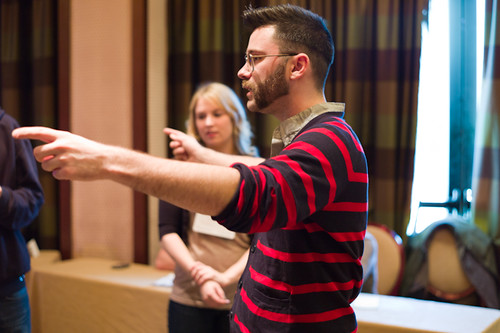
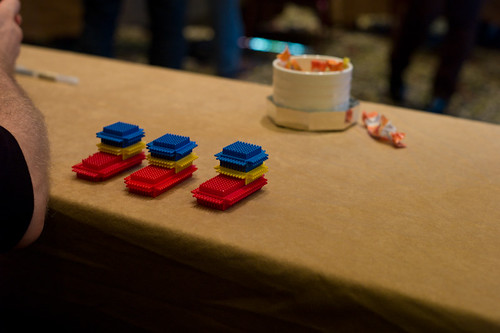
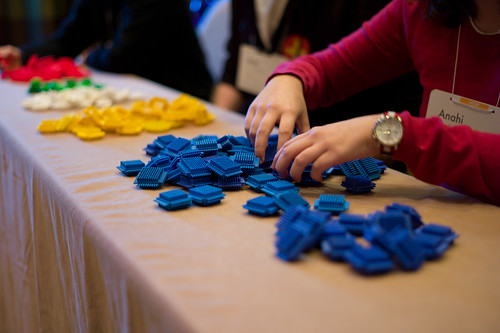
After introductions by Mike and a bit of a discussion about what advanced design might be ((I mentioned I was also quite interested in *advancing design in the sense of moving it closer to the locus of decision making, alongside of the business-y types)) Mike presented the workshop exercise. We were to build boats. Little boats. Made of plastic bits sort of like Legos but, as we would find out later — subject to subtle variations in how they can be assembled, even much more than the typical Lego brick. ((* Update: via @rhysys — they are called Stickle Bricks! *)) The group was broken up into several roles — customers, customer liaison, builders, suppliers, plant managers, quality assurance. Each group played the roles you would expect in the construction of to-spec boats. Customers would place orders which would be relayed to the operation. I was a builder so I basically tried to assemble boats as quickly as possible, making horrible but not-obvious mistakes which resulted in boats being delivered…and then rejected. Each round was broken up into 10 order cycles that ran for a short, fixed amount of time. In that period we’d try to assemble the requested amount of boats, which the customers could reject for flaws. Flaws were sent back to be disassembled so we could try again, but things moved quickly. At the end of the round ((which consisted of a number of order cycles)) a tally was made to determine the per-unit cost based on factors such as — number of workers, number of delivered boats, quantity of raw materials left over, etc. All the things you might understand to influence the cost of a boat. At the end of each round, there was a short amount of time to reconfigure the whole “plant” — increase builders, rearrange how materials moved from source to assembly, break apart assembly into multiple steps, fire people, etc. This was all in order to decreate the cost per boat. We actually did really horribly the first time — target cost: $15. our cost, like..$2500. miserable. We got better over two more rounds, but still only got down to about $30+ or something.
Some insights from this exercise, which is derived from a familiar MBA exercise. First, designers don’t seem to want to fire anyone. Second, MBA people are more than willing to fire workers (based on Mike’s description of when he participated in the exercise at a sort of MBA program). Third, companies that make things — even a few of them and not in the millions of them — are optimized for themselves to be efficient. Change breaks that kind of optimization, resulting in less efficiency, higher costs, etc.
((That third point is one reason I guess we here at the Laboratory prefer small refinements that make big impacts. Making something just a bit better, or refining it with such tenacity — simple, small, thoughtful refinements — that the consequences can become significant without significantly challenging the need for efficiency.))
In the lead-up to this exercise, Mike introduced a few simple yet important tenets surrounding advanced design. There are two basic ways for a company to compete: (1) It can be cheap; (2) It can be different (be something else.) And he introduced one of these curious “Laws” that we here at the Laboratory had never heard of: Parkinson’s Law which basically states that work expands so as to fill the time available for its completion. Or, stated another way: The demand upon a resource tends to expand to match the supply of the resource. ((And yet another way that the Laboratory’s Bureau on Time Management uses as an operating principle: If you wait until the last minute, it only takes a minute to do.))
So then we can think of advanced design as those resources set aside for other activities, which sort of means that it can get a bit out of control if we apply Parkinson’s Law. So — how does one do advanced design? What are some models and approaches?
For the workshop, Mike looked at three case studies of advanced design studios: Nokia, Microsoft and Nike. Each has somewhat different approaches to advanced design, which he laid out. ((I may get the details of the case studies slightly off, but the substance is what I recall and what I think is the significant points.))
3 Approaches to Advanced Design
1. The Outlier
This is the advanced design studio that thinks about “what if?” scenarios, and explores to the side, looking at perhaps total departures from the conventional wisdom. Real out-there stuff that challenges and provokes. He offered three examples of The Outlier: BMW’s Gina Concept car from 2008; Nokia’s Homegrown project; Xbox Kinect
2. The Pantry
A bit like squirreling things away in the pantry for when the weather goes all awry and you’re trapped and can’t get out and don’t want to starve. You do things even if they’re not assigned to go to market. The case study Mike offered was Nike who’s design studio maintains an active bit of work exploring, researching new materials and the like. In the case study, Nike was outdone by Under Armour sports kit who created an intense following amongst various gladiator sports like Football and the like. They broadsided Nike whose marketing people went to design and said, like..help. Design did not start a specific program from scratch to address this, but went to their “pantry” and put together a package from the existing “advanced design” material to create a bit of sports kit that made Football’rs look super scary..like robotic gladiators. Plus, presumably — it worked as equipment. One intriguing thing Mike mentioned was that some folks had been doing some studies on motion and the like with sports folks and found out that feet and hands move the most, so they highlighted feets and hands by bringing out these intense dayglo colorations to the materials used in gloves and sneakers so the players *look fast. I found this fascinating.
3. The Northstar
This is where design works towards an advanced goal, but it’s more an aspirational target that is steered towards, perhaps indirectly. This might best be described as evolving a vision, refining from what’s out there. This I think captures to a certain extent what *vision work does, although sometimes vision work is basically just a nice thing to look at without the tectonics that could activate design work. The challenge is to avoid just creating something that’s cool to look at but doesn’t give enough to make it start becoming material.
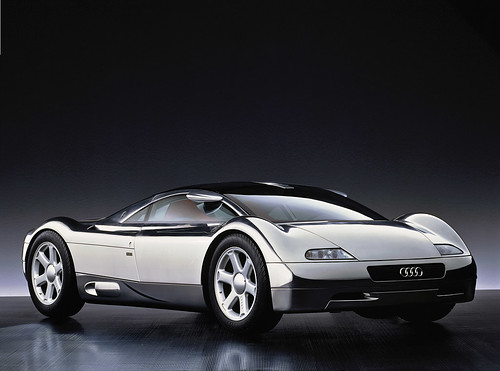
1991 Audi Avus Quattro Concept Car
The example Mike offered in this case was Audi Avus concept car that (I know nothing about cars except how to drive them, sorta) that provided some radical new lines in 1991. It became a sort of objective point in a way — guiding the evolution of their surfacing and configurations so that over time Audi cars begin to take on the features of this Avus concept over time. The Avus provides the “Northstar” for the design team. Now — whether its stated expressly as in a lead designer saying..in 20 years lets get *here, or if it is less formal perhaps does not matter so much. Its more that this vision becomes quite tangible over time, an evolution of the car DNA.
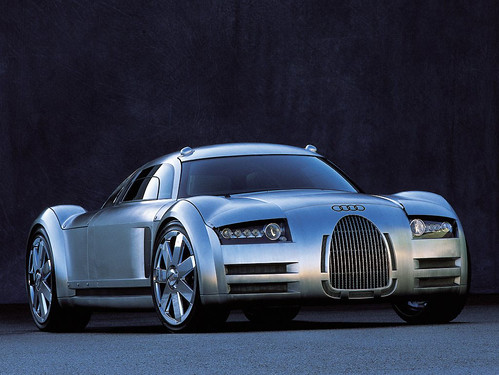
Audi Rosemeyer
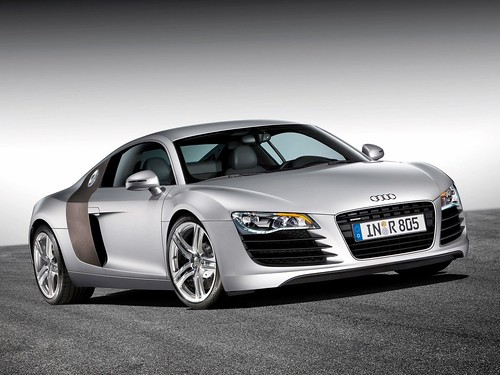
Audi R8
What I find most intriguing about this sort of vision-y Northstar case of Audi in particular is that they are able to stay on course. Twenty years is a long time — even, it seems to me, in the world of automobile design where things change exceptionally slowly because of the momentum and levels of commitment necessary for manufacturing and tooling and all the rest. Yet somehow they are able to keep their eyes on this objective that must’ve seemed quite radical at the time, especially if you consider what Audi looked like in 1991.

The 1991 Audi 200 Turbo
Some random insights that came up during the workshop.
* The Apple model isn’t reproducible perhaps because it is quite driven by the owners themselves and their personalities and abilities to drive change.
* Advanced design is about change. The instinct of a company is optimization; reduce risk and costs; it will reject change.
* Our role as advanced design is to help companies *prepare for change rather than execute it. In other words, be there when things go badly and people around you start losing their head and blame you while you keep yours, and you continue to trust yourself when all those around you doubt you — in other words, when panic and confusion sets in, advanced design can lead at those moments of epic, systemic change.
What is advanced design?
Let’s take this from the perspective of “advancing” design. The “advanced” moniker seems quite old fashioned. Advancing design, or advanced designing seem like useful semantic word play. The semantics help me think about design as something that can move forward (advancing design), rather than designing something in advance of something else (as advanced design would imply), or designing in a way that is different from what is designed today (or what is thought of as design today). In that way, advancing and poking and provoking means more than differentiation. It means more than using advanced techniques.
Some notes/thoughts about what advanced/advancing design or advanced designing might be:
* working through ideas differently
* designing the way of designing always, for each and ever
* iteration, refinement — put it up, strip it back, put it back up again
* communicating tangibly, materially
* storytelling — film, prose, language
* design fiction – actively suspending disbelief. making props and probes and prototypes.
* proto-typing – making stuff, in the shop, at the bench, learning by making and doing
* photography – way better than clip-art and it forces a different kind of conversation and moves things away from *only working at the screen in Illustrator
Why do I blog this? Because I went to the workshop; it made me think of a few useful things; I’ve been sitting on this in draft state for almost two months.
Continue reading IxD 2011 Designing Advanced Design Workshop
A Call for Papers for an intriguing sounding workshop expanding upon and evolving the Design Fiction ideas.
This full-day workshop aims to explore how grounded ethnographic and action research methods can be transformed into fictional and speculative designs that provide people the kinds of experiences and tools that can lead to direct community action in the development and implementation of new pervasive technologies.
Submission of position papers 1 April, 2011
Notifications of acceptance 30 April, 2011
Final papers due 27 May, 2011
Workshop 30 June, 2011
Organisers
Dr Anne Galloway is Senior Lecturer, Design Research in the School of Design, Victoria University of Wellington.
Dr Ben Kraal is Research Fellow with the People and Systems Lab, Queensland University of Technology.
Professor Jo Tacchi is Deputy Dean, Research and Innovation in the School of Media and Communication, RMIT.
Fun stuff! More here.
Continue reading Design Culture Lab: Ethnographic Fiction & Speculative Design Workshop
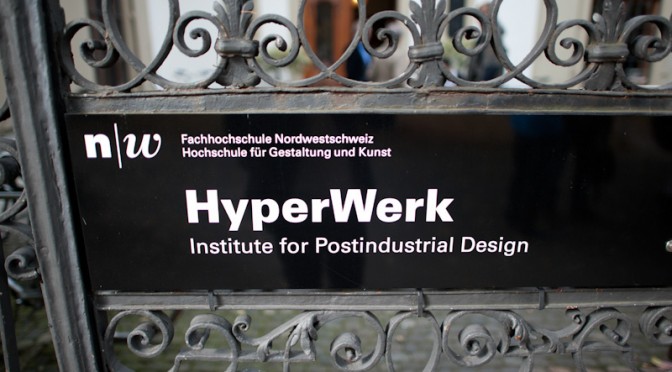
I’ve been away for awhile so obviously I’m just now catching up with some notes for the events and activities of the last few weeks. One thing I want to make a note about is the fun workshop that Nicolas and I facilitated at the Swiss Design Network conference in Basel Switzerland late last month. The workshop was largely Nicolas’ organization and we took advantage of the conference theme of “Design Fiction” to consider the topic of failure in design — failure as a guide and approach and provocation together with the considerations that design fiction can offer.
Nicolas has posted the notes from the workshop
It was a relatively short workshop — a couple of hours in total. Initially I was nervous that there would be not enough guidance to allow the participants to grab onto the material enthusiastically. That proved to be wrong. After an initial presentation that went over the topic of design fiction and failures that Nicolas had prepared, we broke the approximately 30 or so participants into groups of four or five individuals. There were three assignments that we had prepared that each group was meant to conduct. After completing each assignment — which lasted from 20-25 minutes each — the group turned inward and shared some summary insights, results and conclusions. They didn’t know all the assignments ahead of time.

The first assignment was to consider where and when failure happens in design. Without a specific definition of what constitutes failure, the assignment was meant to warm things up by creating a debate and set of examples as to what failure was and when and how it occurs. From Nicolas’ notes (my notebook has escaped me temporarily):
- #Wrong hair color, not the one that was expected
- #Help-desk calls in which you end up being re-reroute from one person to another (and getting back to the first person you called)
- #Nice but noisy conference bags
- #Toilet configuration (doors, sensors, buttons, soap dispensers, hand-dryers…) in which you have to constantly re-learn everything.
- #Super loud and difficult to configure fire alarms that people disable
- #Electronic keys
- #Garlic press which are impossible to clean
- #On-line platforms to book flights for which you bought two tickets under the same name while it’s “not possible” from the company’s perspective (but it was technically feasible).
- #Cheap lighter that burn your nose
- #GPS systems in the woods
- #Error messages that say “Please refer to the manual” but there is not manual
- #Hotel WLAN not distributed anymore because hotel had to pay too many fines for illegal downloads
- #Refrigerators that beep anxiously to indicate the door is open, but do so even when you’re busily loading groceries.
This assignment was useful to begin the thinking about failure. The goal was less about creating a definitive or definitional list and more about thinking beyond and using examples as motivators and things to think with.
The next assignment was essentially the first but to create examples that one might anticipate as a typical failure in the future — the design fiction failures. Things that could occur given that everything fails to meet our highest expectation or (as I’m particularly interested in) the highest of the hype that surrounds new designed stuff. Epic failures, or just routine annoyances were all open for consideration. How might the cloud computing promise fail in both the major disaster ways — as well as the small, wtf!? sort of ways.
Again, from Nicolas’ notes:
- #Identity and facial surgery change, potentially leading to discrepancies in face/fingerprint-recognition,
- #Wireless data leaking everywhere except “cold spots” for certain kind of people (very rich, very poor),
- #Problems with space travelling
- #Need to “subscribe” to a service as a new person because of some database problem
- #People who live prior to the Cloud Computing era who have no electronic footprint (VISA, digital identity) and have troubles moving from one country to another,
- #3D printers accidents: way too many objects in people’s home, the size of the printed objects has be badly tuned and it’s way too big, monster printed after a kid connected a 3D printer to his dreams, …
- #Textiles which suppress bad smells also lead to removal of pheromones and it affects sexual desire (no more laundry but no baby either)…
- #Shared electrical infrastructure in which people can download/upload energy but no one ever agreed on the terms and conditions… which lead to a collapse of this infrastructure
- #Clothes and wearable computing can be hacked so you must now fly naked (and your luggage take a different flight)
I was particularly taken by the 3D printer example. There’s of course lots of excitement about the possibilities of 3D printers in the home so that everyone makes their own stuff that they need. But, making stuff is hard and inevitably open to all kinds of crazy failures such as described here. Also — what do people do with the materials when they mess something up? How is the plastic (or whatever it ends up becoming — maybe noxious nasty stuff) get recycled? Will there have to evolve an entire system of rematerializing the goop? What about the equivalent of the print failures we often experience where one document ends up printing one letter per page, after page after page and we don’t notice until fifty sheets of paper have been used? Or when we scale something wrongly and the machine blindly goes ahead and prints something at 3 meters when we meant 3 millimeters? All these sorts of things will happen — can we use these insights to help make decisions about what and how to design? Can we start to communicate these failures as a way to design not with the expectation that the world is perfect — but that the results of designs have chinks and kinks in them?
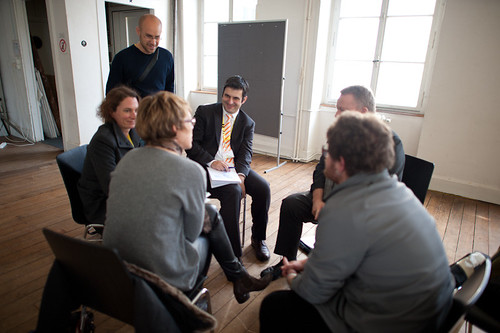
The final activity was to think about possible taxonomies for designed failures — what are the types and kinds of failures as we’ve discussed them in the previous two assignments?
- #Short sightedness/not seeing the big pictures
- #Failures and problems that we only realize ex-post/unexpected side-effects
- #Excluding design
- #Bad optimization
- #Unnoticed failures
- #Miniaturization that doesn’t serve its purpose
- #Cultural failures: what can be a success in one country/culture can be a failure in another
- #Delayed failures (feedback is to slow)
- #When machines do not understand user’s intentions/technology versus human perception/bad assumptions about people (”Life has more loops than the system is able to understand”)
- #Individual/Group failure (system that does not respond to individuals, only to the group)
- #System-based failures versus failures caused by humans/context
- #Natural failures: leaves falling from trees considered as a problem… although it’s definitely the standard course of action for trees)
- #Good failures: Failure need interpretation, perhaps there’s no failure… alternative uses, misuses
- #Inspiring failures
- #Harmless failures
Why do I blog this? Well — just mostly to get some notes from the workshop up to share. I’m learning quite a bit from Nicolas on the failures theme, and perhaps its a way to answer a question that Chairman Bruce has lofted — now that we “get” the idea of design fiction and it seems to be inspirational for folks and useful in that regard — witness the theme of the Swiss Design Network conference this year. But..okay. We get it. Now what? How does the idea of design fiction either operationalize or become part of specific sorts of design practices in some informal or formal ways? It’s happening of course — all over the place and not because of this idea of design fiction itself, either how I’ve discussed it over the last 18 months or so, or how it’s been described and enacted by many people and agents. It’s not just about science fiction of course — and this was the topic of a paper at the conference that I may have the energy to describe in an upcoming post. But it is useful in very direct ways with the activities and goals of design generally speaking, that much is clear.
